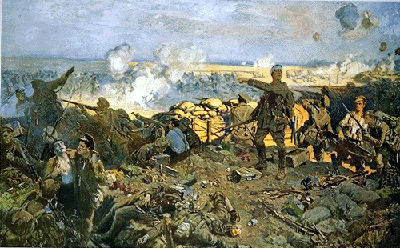Fred Fisher, VC, student, soldier (born 3 August 1894 in St. Catharines, ON; died 24 April 1915 in St-Julien, Belgium). Lance Corporal Fisher’s act of bravery made him the first Canadian in the First World War to earn a Victoria Cross (VC), the highest award for bravery among troops of the British Empire.

Early Life
Fred Fisher was born in 1895 in St. Catharines, Ontario. In 1900, his family moved to Niagara-on-the-Lake, followed by moves to nearby Dunnville and finally to Montréal. In 1912, he enrolled in McGill University to study engineering. He was both a good student and a keen athlete.
First World War
Two days after the First World War broke out in August 1914, Fisher joined the 13th (Royal Highlanders of Canada) Battalion and sailed as a member of the 30,617-strong First Canadian Contingent to Britain on 3 October (see Canadian Expeditionary Force). During training on England's muddy Salisbury Plain in the bitter winter of 1914-15, Fisher was appointed lance-corporal. He arrived in northern France in February 1915 as a part of the Canadian Division. His battalion’s first tour of front-line duty occurred in March.
Second Battle of Ypres
By mid-April, the Canadian Division was one of six Allied divisions deployed in a great arc along the Ypres Salient — a bulge in the Allied lines — in Belgium. Fisher’s 3rd Brigade occupied the left half of the Canadian Division’s 4,500-metre front line, around the town of St. Julien. Within the brigade, Fisher’s 13th Battalion was left forward.
At 5 pm on 22 April, a greenish-yellow cloud of chlorine gas drifted toward the lines of the French 45th Algerian Division, holding the front immediately north of Fisher’s unit. The gas was accompanied by heavy artillery fire and followed by a German attack. Many of the French colonial troops died gasping in their trenches, while others broke and fled rearward. Three German divisions streamed through a six-kilometre gap that opened up next to Fisher’s battalion.

The 10th (St. Catharines) Battery with four 18-pounder artillery guns was in this gap and kept up heavy fire on the advancing Germans, forcing some to dig in or withdraw. When the battery commander realized he was about to be overrun, he requested infantry support. Sixty soldiers, plus a Colt machine gun under Fisher, were sent.
Fisher worked his way forward with his machine-gun crew to an isolated building that covered the area where the Germans were digging in. He opened fire and stopped the enemy advance in the area, although the rest of his four-man team was cut down. This action likely saved the 10th Battery’s guns, which were able to withdraw by 11 pm. It also resulted in the award of the Victoria Cross to Fisher — the first Canadian to earn the VC in the war.
Fisher fought throughout the next day with his machine gun, but was killed in action. His body was never recovered.

Memory
Fisher is commemorated in the city Ypres (now Ieper), Belgium, on the Menin Gate Memorial, which honours 55,000 British Empire soldiers — including nearly 7,000 Canadians — who died during the First World War in the Ypres Salient with no known graves. His inscription reads: "Fisher. F. V.C."
Memorial plaques also honour his bravery at his unit’s armouries in Montréal and his home town ofSt. Catharines.

(See also : The Canadian Great War Soldier and Evolution of Canada's Shock Troops)

 Share on Facebook
Share on Facebook Share on X
Share on X Share by Email
Share by Email Share on Google Classroom
Share on Google Classroom


